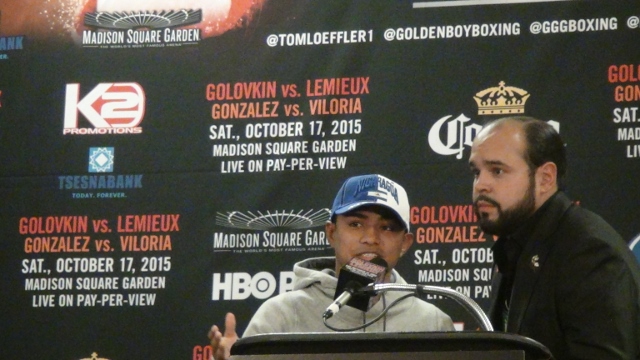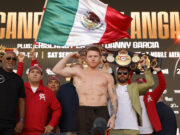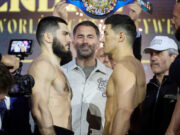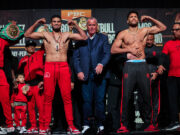
By Norm Frauenheim–
Saturday is an anniversary. The calendar repeats itself. Maybe, history will too.
Roman Gonzalez and Juan Francisco Estrada meet in a fight featuring two of the best from boxing’s lightest divisions exactly 28 years since Michael Carbajal and Humberto Gonzalez fought for the first time.
Carbajal and Gonzalez were junior flyweights on March 13, 1993. So-called little guys, 108 pounds each. Combine the two and you’d barely have one heavyweight in today’s sumo-sized weight class.
But the little was gone nearly three decades ago, knocked out by Carbajal and Gonzalez after a bout long-remembered for its big-boy impact. Carbajal got up twice, first in the second and again in the fifth. Gonzalez went down once and stayed down, beaten in the seventh at the Las Vegas Hilton.
It was violent on any scale. It was dramatic on every scale. It set a standard, still there and perhaps still unequalled in any of the divisions at the bottom of the scale.
From 115 pounds and down, there is still a search for another fight that can again re-define the fighters at weights so often overlooked.
Gonzalez and Estrada are called junior-bantamweights or super-flyweights. Pick your acronym. The weight is the same: 115. The pick here is Super Fly, as in Curtis Mayfield.
Here’s hoping somebody plays Mayfield’s classic soundtrack to a 1972 film with the same name when they enter the ring in Dallas (DAZN, 8 p.m. ET/5 p.m. PT).
Both Gonzalez (50-2, 41 KOs) and Estrada (41-3, 28 KOs) have been super at lighter weights. Their bout Saturday is rematch of a fight at 108 pounds, which Gonzalez won by unanimous decision in November 2012 at the Los Angeles Sports Arena. A lot has happened since then. The Sports Arena is gone, torn down in 2016. Gonzalez is 33, no longer 24 and entering his prime. Estrada is 30, no longer 21 and tireless.
Their sequel is a little – perhaps a lot – too late. Carbajal and Gonzalez wasted little time. They fought twice more, both at 108 in 1994, first at The Forum in Inglewood, Calif. and then Mexico City. Neither rematch compared to the original. Gonzalez won both, scoring a split decision at The Forum and a majority decision in Mexico City.
Nevertheless, the first fight left a public appetite for more. The Forum rematch drew a crowd of 15,102. It was full of fight fans and celebrities, including Magic Johnson who had a seat on a floor he so often dominated during his days with the Showtime Lakers.
The second rematch drew a crowd of an estimated 30,000 at an old bullring.
There haven’t been audiences that big for any bout in the light divisions since then or perhaps before then.
Those numbers also added up to purses still never equaled at any of the lightest weights. Carbajal signed for a promised $1 million for the first rematch. The reported seven figures made him the lightest fighter to ever collect the sum. He’s still at the top of that historical pay scale.
That surprises him.
“Then, I thought this was just the beginning of something new,’’ said Carbajal, now 53 and still living on the street in the central Phoenix neighborhood where he grew up.
It is surprising, mostly because of Gonzalez, a masterful tactician with a mixture of great balance and power. He might not have Carbajal’s ferocious power or the tactical skill of the brilliant Ricardo Lopez, the best ever at 105 pounds.
But the Nicaraguan has displayed enough of both.
At junior-fly (108) and flyweight (112), Gonzalez was as complete a fighter as any. It propelled him to the top of the pound-for-pound debate. After Floyd Mayweather’s announced retirement, The Ring made him the lightest ever to be No. 1 in the publication’s 2016 ratings.
Then a flyweight, Gonzalez decided to move up the scale in pursuit of bigger money. He wanted a $1-million payday. He didn’t get it. Instead he got a couple of losses, both to Thailand’s Srisaket Sor Rungvisai at 115 pounds.
Gonzalez’ biggest payday was $600,000 for a knockout loss to Rungvisai, according to contracts filed with the California State Athletic Commission after Gonzalez defeat, his second straight after a decision loss to Rungvisai, both in 2017.
There are reasons for weight classes. There’s price in not remembering them, too. The undersized Gonzalez paid for the jump. Carbajal stayed at 108 throughout his career.
“I never had to go up,’’ said Carbajal, whose decade-long career would end in 1999 with an 11th-round knockout of Jorge Arce, later a bantamweight and super-bantamweight champion.
The fights came to him, said the Hall of Famer, who had the advantage of being an American whose pro career was preceded by media visibility that came with his Olympic bouts at the 1988 Games.
He got a silver medal after a controversial loss for the gold to a Hungarian who was never heard from again after the Seoul scores were announced. It was a preview of what the world was about to witness – the outright theft of Roy Jones Jr., who lost gold at light-middleweight to a South Korean. Like the Bulgarian, the South Korean never fought again.
Carbajal and Jones came home known and liked by an American audience that saw them perform with poise, despite the adversity. The fix was in, yet they fought on.
It’s been harder to get known — to win over fans — for Gonzalez and Estrada, a Mexican born in Puerto Penasco, a fishing town on the Sea of Cortez about five hours south of Phoenix.
But maybe this is the time. Maybe the calendar is more than just coincidence. It’s a chance to make, if not repeat, more than just a little history.
























